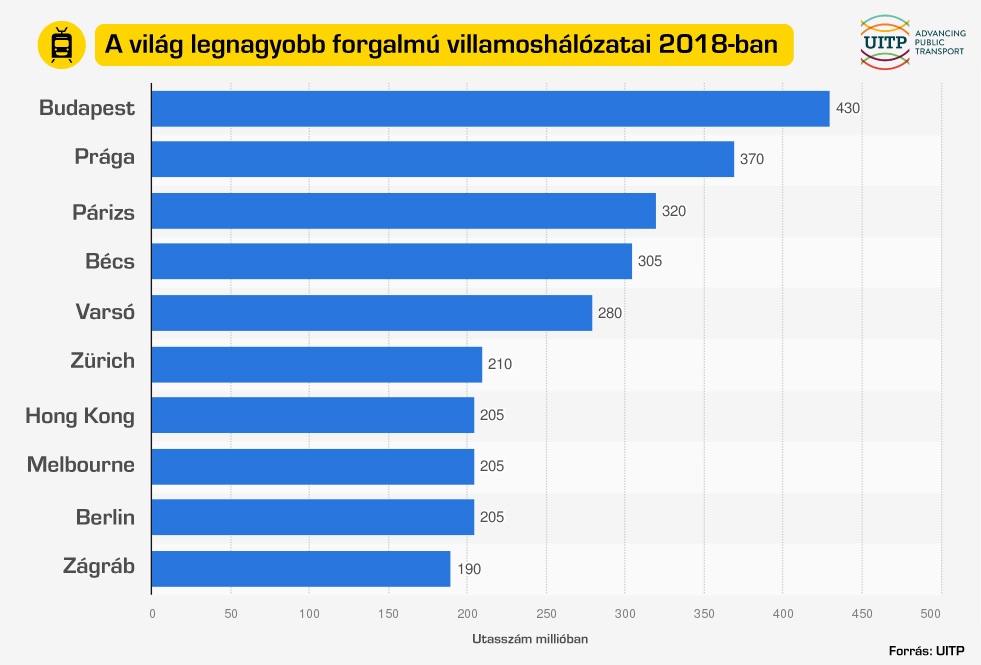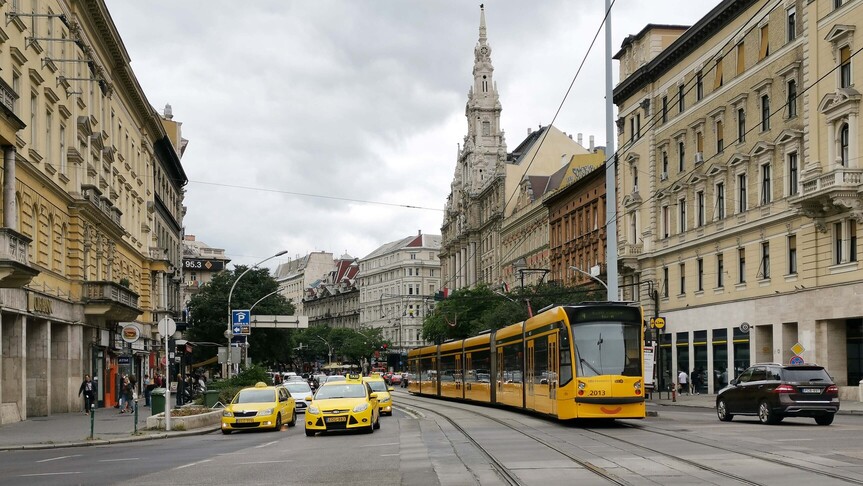Budapest ranked as the world leader in tram transport
Based on the latest data of the International Union of Public Transport (UITP), the Hungarian capital has the highest number of tram passengers in the world. As a result, we can fairly call Budapest the world leader in tram transport.
As the Hungarian news portal Helló Magyar reports, Central Europe’s advanced tram network is the result of historical events. One reason could be the lack of money during socialism. Living standards were lower in this region. Only a narrow section of society could afford to buy a private car, so tram networks had a prominent role in public transport.
The contrary could be experienced in Western Europe where several tram lines were dismantled in the 1950s, 60s and 70s. The difference can be best seen by examining the tram network of Berlin, where only Eastern Berlin retained its tram network, with only a few trams stretching into the western part after the fall of the wall.
In Western Europe (mainly in France) and in America, the tram renaissance started in the second half of the 1980s. Currently, France boasts a well-developed tram network in almost 30 French cities. Moreover, the new developments represent a modern, passenger-attracting technical standard. Still,
these few lines cannot compete in terms of passenger numbers with the performance of the Central European tram network.
Only Paris made it to the TOP3 of the list that ranked cities with the busiest tram networks in the world.
The largest tram network in the world by track length can be found in Melbourne. Additionally, Hong Kong has also retained a well-developed tram network from the 19th and 20th centuries built under British influence. Both of the cities are continuously developing their tram lines.
In contrast, the once huge networks of London, New York and Los Angeles have practically disappeared by the passage of time. Only one tram was re-launched in London’s suburbs at the end of the 20th century.
As far as Eastern Europe is concerned, Moscow and St. Petersburg have the largest metro systems. The latter boasts the second-longest network in the world, but the number of passengers did not even make it into the top 10. This can be explained by the technically neglected and unattractive networks, due to which there are fewer and fewer passengers choosing this form of public transport.
The Hungarian capital has a well-developed tram networking. On top of that, based on the most recent UITP data (2018),
Budapest made it to the top in the ranking of the busiest tram networks in the world.

Even though the Rákóczi and Bajcsy-Zsilinszky road tram lines were completely abolished in the past, Budapest can take pride in its well-developed tram network.
Moreover, these lines might revive soon if the current government and Budapest plans will be carried out.
Within the framework of the development project, the plans for the extension of the Buda Tramway have been finalised. It will extend from Szent Gellért Square along the Danube bank, then after the Rákóczi Bridge, turning west to Budafoki Road. As part of converting Budapest’s City Park into a car-free zone, a new bridge will connect the 13th and 14th districts of Budapest, where a tram line will be constructed, extending the ring of Tram 3 and providing better connectivity. Additionally, another tram line will pass over the new Danube bridge that will connect the rapidly developing areas of South Buda, Csepel and South Pest. The surrounding area of Nyugati Railway Station will also be revamped. Developers will have to submit proposals for the future Bajcsy-Zsilinszky Road line through Nyugati Square, the demolition of the flyover and the new tram line.
Source: hellomagyar.hu



Another reason why cars were unavailable was one had to be a card carering commy for the communist had first priority to get a car since the Ruskies controlled the permit even than a three year wait
Rightly – we are deserving to be graded Number 1 – in Tram Transport.
Future plans – as this article refers exciting and the ABILITY – to move people around our Nations Capital – our tramway network, will continue to play the Important role it does – moving forward.
Do I really need to use the car to-day ???
Melbourne, Victoria – interesting.
The continual Sprawl-Spreading – of this City – flat lands overall of the on-going residential housing estates – the FAILURE of the Victorian Governments over decades is that they have not INCREASED tram line track length into for decades these NEW – residential areas.
Melbourne – tram line track length – go back 50 years – then look at 2021 – compare the population of Melbourne – which massively has expanded and grown over 50 years – and the tram line track length – has not EXPANDED as it should.
Melbourne – no Metro service.
It is under construction but some 3 – 5 years off being a Functioning addition to its needs as Australias second largest City – as a means of Public Transport.
Melbourne – its International Airport called Tullarmarine – has no metro – no trains – no trams nor light rail.
It’s distanced from the heart of Melbourne and from a Public Transport perspective – its a Disgrace.
Tourist – do find it un-beleivable – an International Airport since late 1960’s – that has the appalling all but nil availability of Public Transport.
Melbourne – forward thinking – thats a problem – has such scope to extend its Tramway track length – and the NEED.
Sydney – Australias largest Populated State – had a tram network up until the 1960’s – when it was CEASED.
The World famous Sydney Opera house is built on what was Sydneys largest tram depot.
Sydney – has (2) two light rail services – introduced in the last 2-4 years.
They are relatively short in track distance BUT one of the lines due to rolling stock – made in CHINA – bad decision – having cracks in carriages, was closed November 2021 – until such time the carriage faults have been CORRECTED.
Initially – the State Government of N.S.W. – Transport Division indicated a 12 month closure of public service to this light rail service, which at present, could see it operating again by end of June 2022.
Sydney – has hills and a Magnificent Harbour that divides to a degree its population.
Sydney has hills much closer to it – its heart as a City – than Melbourne.
Sydney – can further extend its Light Rail System – European Proven Quality Rolling Stock – like ours in Budapest,Hungary – but it will NEVER going forward have Tram/Light Rail track length to that of Melbourne.
Chinese – jury remains STILL very much un-decided at there ability to build QUALITY public needs of Transportation.
Melbourne – its newest suburban trains – that in time can run on there Metro Line – purchased from China – over (2) two years ago, have YET – to be incorporated into there Suburban System.
They have presented Cataclymic on-going – PROBLEMS.
Victorian Government – spent millions of forint building a new testing and track facility outside of Melbourne – to endeavour to SORT Out – the Mass problems with these Chinese trains.
Love – our Trams in Budapest,Hungary and other Cities we have them in – Fantastic.
It will be glorius – picture this with me – tram from Deak Ferenc ter – up Bajcsy-Zsilinszky ut – to the RE-VAMPED – Re-Modeled – Nyugati ter – looking out the tram as you appraoch Nyugati ter – the Splendid Facade of Nyugati Station.
It’s going to HAPPEN – and this article – gives a clear in-sight to FACT – that our TRAMS – are very much in the “Heart & Soul” of Budapest and Hungary.